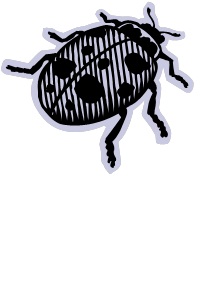 Lady Beetles - December 12, 2012 Jeff Schalau, Agent, Agriculture & Natural Resources University of Arizona Cooperative Extension, Yavapai County The Yavapai County Cooperative Extension office has received many calls this fall about trees that appear to have been lacquered. The trees and the ground below them are covered with a shiny, sticky substance. Many readers are probably aware of the cause, but if you are still wondering, it was honeydew produced by large numbers of aphids. The sugary honeydew can be rinsed off with water, but donít allow it to stay on painted surfaces for long because mold can grow and cause lasting damage to the paint. Our mild fall temperatures likely gave the aphids a little more time to feed Ďn breed. As usual, the increase in aphid populations was followed by an increase in lady beetle populations. This predator/prey relationship is common and observable in our landscapes, gardens, orchards, and wildlands. Lady beetles, often called Ladybugs, are the most commonly known of all beneficial insects. Both adults and larvae feed on many different soft-bodied insects with aphids being their main food source. Knowing that lady beetles will arrive in your garden helps you tolerate spring aphid populations. Learning to recognize the eggs and stages of the lady beetle life cycle will help you monitor their populations and reduce some gardenerís use of insecticides. Most people recognize adult lady beetles by their shiny, convex, half-dome shape. They are often orange with black spots. However, given over 500 species found north of the Mexican border, there is much variation in color: from bright colors with spots to dark colors with few or no markings. Most lady beetles are predaceous as both larvae and adults and vary in adult body length between 3 to 7 mm. Aside from aphids, lady beetles can also feed on many other pests such as soft-scale insects, mealybugs, spider mites and eggs of the Colorado Potato Beetle and European Corn Borer. One larva will eat about 400 medium-size aphids during its development to the pupal stage. An adult will eat about 300 medium-size aphids before it lays eggs. About three to ten aphids are eaten for each egg the beetle lays. More than 5,000 aphids may be eaten by a single adult in its lifetime. Usually the life cycle from egg to adult requires about three to four weeks, or up to six weeks during cooler spring months. In the spring, overwintering adult females find food, then lay from fifty to three hundred eggs in or near aphid colonies. Egg masses are small, bright orange ovals laid on end in groups. Eggs hatch in three to five days, and larvae feed on aphids or other insects for two to three weeks. Larvae are multi-colored, often mostly blue with red or orange markings and resemble little alligators (or in Arizona, Gila monsters). Larvae of most species go through four instars (stages between molts) looking similar but increasing in size each time before they pupate. The pupae are often attached to leaves, tree trunks, and structures and look similar to the larvae but are stationary and rounded. The pupae emerge as adults in seven to ten days. There may be five to six generations per year. Convergent lady beetles are one of the most common native species. The common name refers to a pair of white convergent dashes on the prothorax (the round plate behind the head). Iíve included some links to more information and photos of several lady beetle species and life stages below. A local person brought in a sample of aphids on Turbinella oak recently. The lady beetles had also colonized the oak and were a species I have not seen very often: the twicestabbed lady beetle. The adults of this species are black with a red spot on each side of their back. We also observed the abandoned lady beetle pupa cases on the oak stem. In Arizona, we have many other lady beetle species. Do not transport them from one place to another. If there is food available or habitat is suitable, they will appear at the proper time. Furthermore, respect and conserve lady beetles (and other beneficial and/or benign insects) by only using insecticides when absolutely necessary and targeting the pest species as closely as possible to minimize impact to non-target organisms. Follow the Backyard Gardener on Twitter Ė use the link on the BYG website. If you have other gardening questions, call the Master Gardener help line in the Camp Verde office at 928-554-8999 Ext. 3 or e-mail us at cottonwoodmg@yahoo.com and be sure to include your name, address and phone number. Find past Backyard Gardener columns or provide feedback at the Backyard Gardener web site: http://cals.arizona.edu/yavapai/anr/hort/byg/. Additional Information Lady Beetles, Colorado State University extension.colostate.edu/topic-areas/insects/lady-beetles-5-594/ Integrated Pest Management - Natural Enemies Gallery (featuring five species of lady beetle), University of California http://www.ipm.ucdavis.edu/PMG/NE/index.html Lady Beetle, Texas A & M Agrilife Extension http://insects.tamu.edu/fieldguide/bimg158.html |